
Attila, frequently called Attila the Hun, was the ruler of the Huns from 434 until his death in March 453. He was also the leader of a tribal empire consisting of Huns, Ostrogoths, Alans and Bulgars, among others, in Central and Eastern Europe. He is also considered one of the most powerful rulers in world history.

The Huns were a nomadic people who lived in Central Asia, the Caucasus, and Eastern Europe between the 4th and 6th century AD. According to European tradition, they were first reported living east of the Volga River, in an area that was part of Scythia at the time; the Huns' arrival is associated with the migration westward of an Iranian people, the Alans. By 370 AD, the Huns had arrived on the Volga, and by 430 the Huns had established a vast, if short-lived, dominion in Europe, conquering the Goths and many other Germanic peoples living outside of Roman borders, and causing many others to flee into Roman territory. The Huns, especially under their King Attila, made frequent and devastating raids into the Eastern Roman Empire. In 451, the Huns invaded the Western Roman province of Gaul, where they fought a combined army of Romans and Visigoths at the Battle of the Catalaunian Fields, and in 452 they invaded Italy. After the death of Attila in 453, the Huns ceased to be a major threat to Rome and lost much of their empire following the Battle of Nedao. Descendants of the Huns, or successors with similar names, are recorded by neighboring populations to the south, east, and west as having occupied parts of Eastern Europe and Central Asia from about the 4th to 6th centuries. Variants of the Hun name are recorded in the Caucasus until the early 8th century.

Aetius was a Roman general and statesman of the closing period of the Western Roman Empire. He was a military commander and the most influential man in the Empire for two decades (433–454). He managed policy in regard to the attacks of barbarian federates settled throughout the West. Notably, he mustered a large Roman and allied (foederati) army in the Battle of the Catalaunian Plains, ending a devastating invasion of Gaul by Attila in 451, though the Hun and his subjugated allies still managed to invade Italy the following year, an incursion best remembered for the ruthless Sack of Aquileia and the intercession of Pope Leo I.
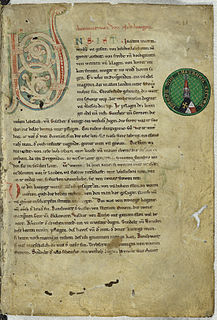
The Nibelungenlied, translated as The Song of the Nibelungs, is an epic poem written around 1200 in Middle High German. Its anonymous poet was likely from the region of Passau. The Nibelungenlied is based on an oral tradition of Germanic heroic legend that has some of its origin in historic events and individuals of the 5th and 6th centuries and that spread throughout almost all of Germanic-speaking Europe. Scandinavian parallels to the German poem are found especially in the heroic lays of the Poetic Edda and in the Völsunga saga.
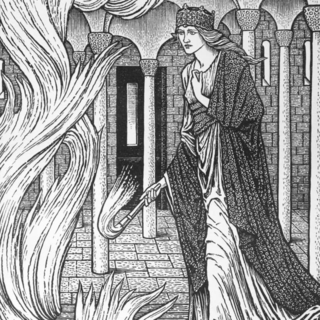
Gudrun or Kriemhild is the wife of Sigurd/Siegfried and a major figure in Germanic heroic legend and literature. She is believed to have her origins in Ildico, last wife of Attila the Hun, and two queens of the Merovingian dynasty, Brunhilda of Austrasia and Fredegund.
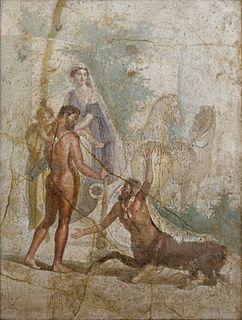
In Greek mythology, Nessus was a famous centaur who was killed by Heracles, and whose poisoned blood in turn killed Heracles. He was the son of Centauros. He fought in the battle with the Lapiths and became a ferryman on the river Euenos.

Pokémon Chronicles, partly known in Japan as Pocket Monsters Side Stories, is a spin-off series of the original Pokémon anime, revolving around characters other than Ash Ketchum.
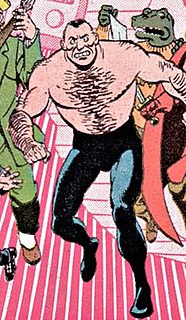
Ibac is a fictional character appearing in American comic books published by Fawcett Comics and DC Comics. He is often depicted as a foe of Captain Marvel.

Waltharius is a Latin epic poem founded on German popular tradition relating the exploits of the Visigothic hero Walter of Aquitaine. While its subject matter is taken from early medieval Germanic legend, the epic stands firmly in the Latin literary tradition in terms of its form and the stylistic devices used. Thus, its 1456 verses are written in dactylic hexameter and the poem includes copious references to various Latin epics of antiquity, especially Vergil's Aeneid.

Attila is a 2001 American television miniseries set during the waning days of the Western Roman Empire, in particular during the invasions of the Huns in Europe.

Die Nibelungen is a two-part series of silent fantasy films created by Austrian director Fritz Lang in 1924, consisting of Die Nibelungen: Siegfried and Die Nibelungen: Kriemhild's Revenge.

Alexander the Great's accomplishments and legacy have been preserved and depicted in many ways. Alexander has figured in works of both "high" and popular culture from his own era to the modern day. Some of these are highly fictionalized accounts, such as the Alexander Romance.
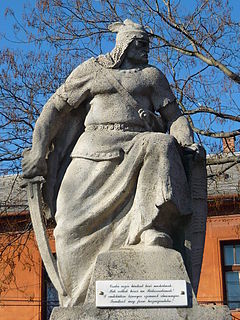
In Hungarian mythology, Prince Csaba was the youngest son of Attila, King of the Huns. A fierce and skilled warrior, he led the Huns to victory in all the battles they encountered over the ages. He is the legendary leader of the Székelys.

Inferno is the first part of Italian writer Dante Alighieri's 14th-century epic poem Divine Comedy. It is followed by Purgatorio and Paradiso. The Inferno describes Dante's journey through Hell, guided by the ancient Roman poet Virgil. In the poem, Hell is depicted as nine concentric circles of torment located within the Earth; it is the "realm ... of those who have rejected spiritual values by yielding to bestial appetites or violence, or by perverting their human intellect to fraud or malice against their fellowmen".

Dante's Inferno: An Animated Epic is a 2010 adult animated dark fantasy film. Based on Dante's Inferno video game which is itself loosely based on Dante's Inferno, Dante must travel through the circles of Hell and battle demons, creatures, monsters, and even Lucifer himself to save his beloved Beatrice. The film was released on February 9, 2010.
Tarkan is a fictional Hunnic warrior created by Turkish cartoonist Sezgin Burak.
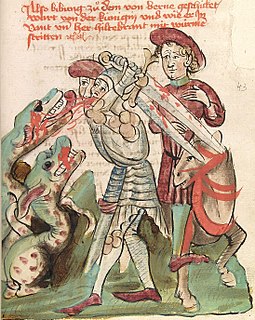
Dietrich von Bern is the name of a character in Germanic heroic legend who originated as a legendary version of the Ostrogothic king Theodoric the Great. The name "Dietrich", meaning "Ruler of the People", is a form of the Germanic name "Theodoric". In the legends, Dietrich is a king ruling from Verona (Bern) who was forced into exile with the Huns under Etzel by his evil uncle Ermenrich. The differences between the known life of Theodoric and the picture of Dietrich in the surviving legends are usually attributed to a long-standing oral tradition that continued into the sixteenth century. Most notably, Theodoric was an invader rather than the rightful king of Italy and was born shortly after the death of Attila and a hundred years after the death of the historical Gothic king Ermanaric. Differences between Dietrich and Theodoric were already noted in the Early Middle Ages and led to a long-standing criticism of the oral tradition as false.

Das Nibelungenlied is a novel by German writer Albrecht Behmel about the medieval epic of the same name. The story follows the Middle High German original.

Inferno is a fictional superhero appearing in American comic books published by Marvel Comics.
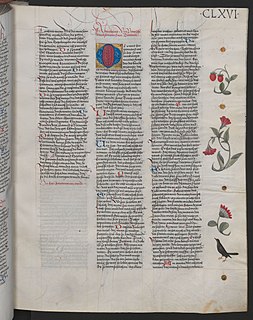
Biterolf und Dietleib is an anonymous Middle High German heroic poem concerning the heroes Biterolf of Toledo and his son Dietleib of Styria. It tells the tale of Biterolf and Dietleib's service at the court of Etzel, king of the Huns, in the course of which the heroes defeat Etzel's enemies, including an extended war/tournament against the Burgundian heroes of the Nibelungenlied. As a reward for their services, Dietleib and Biterolf receive the March of Styria as a fief. The text is characterized by its comedic parody of the traditions of heroic epic.



















